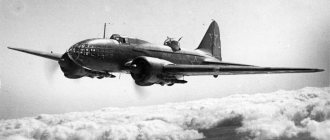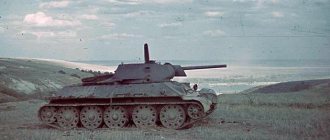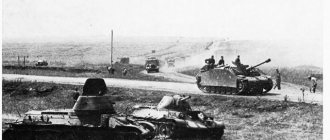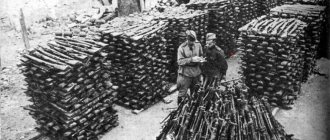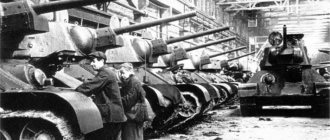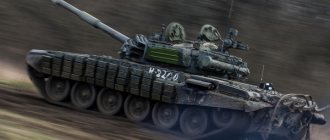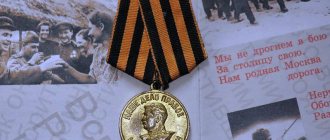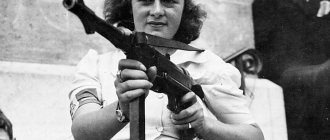Rifles and carbines
The basis of the small arms of the Red Army were magazine rifles with a manual sliding bolt and self-loading rifles. Their long rifled barrel and powerful cartridge with a protruding rim allowed the defenders of the Motherland to successfully fight at a distance of up to one and a half kilometers.
Mosin rifle
The most widespread example of handguns of Soviet soldiers was the 7.62-mm rifle of the 1891 model, better known by the name of its creator, domestic designer Sergei Mosin.
wikipedia.org/Homoatrox/CC BY-SA 3.0
The famous “three-line” was not only distinguished by its amazing simplicity, reliability and unpretentiousness, but also had impressive characteristics for its time. The bullet of the powerful 7.62x54 mm cartridge, created specifically for the Mosin rifle, not only retained destructive power at a distance of up to two kilometers, but was also capable of penetrating lightly armored Wehrmacht vehicles located no further than 500 meters.
The only significant drawback of the “three-line” was the low rate of fire. Manual reloading and a five-round permanent magazine, loaded with clips, had an effect.
Tokarev rifle
The self-loading rifles of Fedor Tokarev - SVT-38 and SVT-40, where the second is an improved modification of the first, were free from the disadvantage of the Mosin rifle.
wikipedia.org / Michele Schiavo / Public Domain
These types of small arms used the same powerful ammunition with a protruding rim, but differed in the presence of a mechanism for removing powder gases for automatic reloading and a detachable 10-round magazine. Changes in the design allowed the SVT-38/40 to significantly increase the rate of fire, which had a positive effect on the effectiveness of the individual soldier in battle. This explains the sympathy of the Red Army soldiers for Tokarev rifles, which they lovingly called “Svetka”.
The disadvantage of this weapon was the need for regular cleaning and lubrication of a large number of moving elements. In the absence of proper care, individual rifle mechanisms could jam.
Submachine guns
Long-barreled rifles were indispensable when fighting at long and medium distances, but when approaching the enemy they turned out to be ineffective. Here, domestic submachine guns, which have a fantastic rate of fire and high density of fire, played a decisive role.
PPD-40
The submachine gun of the Vasily Degtyarev system was used by soldiers of the Red Army at the initial stage of the Great Patriotic War. Using an automation system based on the recoil energy of a free shutter, the designer achieved an unprecedented rate of fire - 1000 rounds per minute. For comparison, the German equivalent of the PPD-40, the MP-40 submachine gun, fired only 500 rounds per minute.
wikipedia.org / VitalyKuz / CC BY-SA 4.0
Together with the 71-round drum magazine, the PPD was a formidable weapon in the hands of Soviet soldiers. The 7.62x25 mm pistol cartridge was effective when shooting up to 200 meters.
The main disadvantages of the PPD-40 were difficulty in production, not the simplest design, as well as high ammunition consumption.
PPSh-41
The titanic work of gunsmith Georgy Shpagin to improve the design of the PPD-40 led to the creation of the legendary PPSh-41, a submachine gun that made an immeasurable contribution to the Great Victory.
The main difference between Shpagin’s creation and its predecessors was a significant simplification of the design while maintaining tactical and technical characteristics. The PPSh-41 was designed in such a way that it could be, firstly, simpler and faster to produce, secondly, easier to maintain, and thirdly, repairable in the field.
wikipedia.org / Georgy Shpagin / CC BY-SA 3.0 fr
The same pistol cartridge, 71-round drum magazine and fantastic rate of fire, coupled with simplicity and reliability, made this submachine gun the favorite weapon of Soviet soldiers. However, for all its advantages, the PPSh-41 was quite inconvenient for regular use as a submachine gun. In addition, it still quickly consumed ammunition, which is a negative consequence of the high rate of fire.
PPS-43
The problems of the PPSh-41 were solved by the Soviet gunsmith Alexey Sudaev, who managed to develop a truly ideal submachine gun, devoid of the shortcomings of its predecessors. The PPS-43 was distinguished by a reduced rate of fire, which amounted to 700 rounds per minute, the use of a convenient box-shaped 35-round magazine, as well as its compact size and folding stock.
wikipedia.org/MKFI/CC BY-SA 4.0
PPS-43 was used by soldiers of the Red Army mainly at the final stage of the Great Patriotic War. This model of small arms is often called the best submachine gun of World War II.
War of engines: weapons of the Red Army before the start of the Great Patriotic War
Modern war will be a war of engines. Motors on the ground, motors in the air,
motors on water and under water. Under these conditions, the one who wins will be the one who wins.
who will have more engines and more power reserves
Joseph Stalin
At a meeting of the Main Military Council, January 13, 1941.
During the years of the pre-war five-year plans, Soviet designers created new models of small arms, tanks, artillery, mortars and aircraft.
More and more advanced destroyers, cruisers, and patrol ships entered service with the fleet, and special attention was also paid to the development of the submarine fleet. As a result, before the start of the Great Patriotic War, the USSR had a fairly modern system of weapons and military equipment, and in some tactical and technical characteristics it even surpassed German weapons analogues. Therefore, the main reasons for the defeats of the Soviet troops in the initial period of the war cannot be attributed to miscalculations in the technical equipment of the troops.
TANKS
As of June 22, 1941, the Red Army had 25,621 tanks.
The most popular were the light T-26s, of which there were almost 10 thousand vehicles, and representatives of the BT family - there were about 7.5 thousand of them. A significant proportion were wedges and small amphibious tanks - a total of almost 6 thousand were in service with the Soviet troops. modifications T-27, T-37, T-38 and T-40.
The most modern KV and T-34 tanks at that time numbered about 1.85 thousand units.
KV-1 tanks
The KV-1 heavy tank
KV-1 entered service in 1939 and was mass-produced from March 1940 to August 1942. The tank's mass was up to 47.5 tons, which made it much heavier than existing German tanks. He was armed with a 76 mm cannon. Some experts consider the KV-1 to be a landmark vehicle for global tank building, which had a significant impact on the development of heavy tanks in other countries.
The Soviet tank had the so-called classic layout - the division of the armored hull from bow to stern successively into a control compartment, a combat compartment and an engine compartment. It also received an independent torsion bar suspension, all-round anti-ballistic protection, a diesel engine and one relatively powerful gun. Previously, these elements were found separately on other tanks, but in the KV-1 they were brought together for the first time.
The first combat use of the KV-1 dates back to the Soviet-Finnish War: a prototype of the tank was used on December 17, 1939 during the breakthrough of the Mannerheim Line.
In 1940-1942, 2,769 tanks were produced.
Until 1943, when the German Tiger appeared, the KV was the most powerful tank of the war. At the beginning of the Great Patriotic War, he received the nickname “ghost” from the Germans. Standard shells from the Wehrmacht's 37mm anti-tank gun did not penetrate its armor.
Tank T-34
Medium tank T-34
In May 1938, the Armored Directorate of the Red Army invited plant No. 183 (now the Kharkov Transport Engineering Plant named after V. A. Malyshev) to create a new tracked tank.
Under the leadership of Mikhail Koshkin, the A-32 model was created. The work proceeded in parallel with the creation of the BT-20, an improved modification of the already mass-produced BT-7 tank. Prototypes of the A-32 and BT-20 were ready in May 1939; based on the results of their tests in December 1939, the A-32 received a new name - T-34 - and was put into service with the condition of modifying the tank: bringing the main armor to 45 millimeters, improve visibility, install a 76-mm cannon and additional machine guns.
In total, by the beginning of the Great Patriotic War, 1066 T-34s were manufactured.
After June 22, 1941, production of this type was launched at Gorky (now Nizhny Novgorod), Chelyabinsk Tractor Plant in Sverdlovsk (now Yekaterinburg), plant No. 174 in Omsk and Uralvagonzavod (Nizhny Tagil). In 1944, serial production of the T-34-85 modification began with a new turret, reinforced armor and an 85-mm gun.
The tank has also proven itself well due to its ease of production and maintenance. In total, more than 84 thousand T-34 tanks were manufactured.
This model took part not only in the Great Patriotic War, it was in many armed conflicts in Europe, Asia and Africa in the 1950-1980s. The last documented case of combat use of T-34s in Europe was their use during the war in Yugoslavia. AVIATION
By the beginning of the Great Patriotic War, Soviet aviation was armed with many types of combat aircraft. In 1940 and the first half of 1941, almost 2.8 thousand modern vehicles entered the troops: Yak-1, MiG-3, LaGG-3, Pe-2, Il-2.
There were also I-15 bis, I-16 and I-153 fighters, TB-3, DB-3, SB (ANT-40) bombers, multi-purpose R-5 and U-2 (Po-2).
The new aircraft of the Red Army Air Force were not inferior to the Luftwaffe aircraft in combat capabilities, and even surpassed them in a number of indicators.
Sturmovik Il-2
Il-2 attack aircraft
The Il-2 armored attack aircraft is the most produced combat aircraft in history.
In total, more than 36 thousand cars were produced. He was called the “flying tank,” the Wehrmacht leadership called him “the Black Death” and “Iron Gustav.” German pilots nicknamed the Il-2 “concrete plane” for its high combat survivability. The first combat units that were armed with these vehicles were created just before the war. Attack aircraft units were successfully used against enemy mechanized and armored units. At the beginning of the war, the Il-2 was practically the only aircraft that, given the superiority of German aviation, fought the enemy in the air. He played a big role in containing the enemy in 1941.
During the war years, several modifications of the aircraft were created.
The Il-2 and its further development, the Il-10 attack aircraft, were actively used in all major battles of the Great Patriotic War and in the Soviet-Japanese War. The maximum horizontal speed of the aircraft at the ground was 388 km/h, and at an altitude of 2000 m – 407 km/h.
The ascent time to a height of 1000 m is 2.4 minutes, and the turn time at this height is 48-49 seconds. At the same time, in one combat turn, the attack aircraft gained a height of 400 meters.
MiG-3 fighter
Night fighter MiG-3
The design team, headed by A. I. Mikoyan and M. I. Gurevich, worked hard in 1939 on a fighter for combat at high altitudes.
In the spring of 1940, a prototype was built, which received the MiG-1 brand (Mikoyan and Gurevich, the first). Subsequently, its modernized version received the name MiG-3. Despite the significant take-off weight (3350 kg), the speed of the production MiG-3 at the ground exceeded 500 km/h, and at an altitude of 7 thousand meters it reached 640 km/h.
This was the highest speed achieved at that time on production aircraft. Due to the high ceiling and high speed at an altitude of over 5 thousand meters, the MiG-3 was effectively used as a reconnaissance aircraft, as well as an air defense fighter. However, poor horizontal maneuverability and relatively weak weapons did not allow it to become a full-fledged front-line fighter. According to the estimates of the famous ace Alexander Pokryshkin, while inferior in the horizontal direction, the MiG-3 was significantly superior to the German Me109 in vertical maneuver, which could serve as the key to victory in a clash with fascist fighters.
However, only top-class pilots could successfully fly the MiG-3 in vertical turns and at extreme overloads. FLEET
By the beginning of the Great Patriotic War, the Soviet fleet had a total of 3 battleships and 7 cruisers, 54 leaders and destroyers, 212 submarines, 287 torpedo boats and many other ships.
The pre-war shipbuilding program provided for the creation of a “large fleet”, the basis of which would be large surface ships - battleships and cruisers. In accordance with it, in 1939-1940, battleships of the "Soviet Union" type and heavy cruisers "Kronstadt" and "Sevastopol" were laid down, and the unfinished cruiser "Petropavlovsk" was purchased in Germany, but plans for a radical renewal of the fleet were not destined to come true.
In the pre-war years, Soviet sailors received new light cruisers of the Kirov class, leaders of destroyers of projects 1 and 38, destroyers of project 7 and other ships. The construction of submarines and torpedo boats was booming.
Many ships were completed during the war, some of them never took part in the battles. These include, for example, the Project 68 Chapaev cruisers and the Project 30 Ognevoy destroyers.
The main types of surface ships of the pre-war period:
light cruisers of the Kirov type, leaders of the Leningrad and Minsk types, destroyers of the Gnevny and Soobrazitelny type, minesweepers of the Fugas type, torpedo boats G-5, sea
hunters "MO-4".
The main types of submarines of the pre-war period:
small submarines of the "M" type ("Malyutka"), medium submarines of the "Shch" ("Pike") and "S" ("Srednyaya") types, underwater minelayers of the "L" type ( "Leninets"), large submarines of types "K" ("Kreiserskaya") and "D" (Dekabrist).
Kirov-class cruisers
Kirov-class cruisers
Light cruisers of the Kirov class became the first Soviet surface ships of this class, not counting the three Svetlana cruisers laid down under Nicholas II.
Project 26, according to which the Kirov was built, was finally approved in the fall of 1934 and developed the ideas of the Italian light cruisers of the Condotieri family. The first pair of cruisers, Kirov and Voroshilov, were laid down in 1935. They entered service in 1938 and 1940. The second pair, Maxim Gorky and Molotov, were built according to a modified design and joined the Soviet fleet in 1940-1941. Two more cruisers were laid down in the Far East; before the end of the Great Patriotic War, only one of them, the Kalinin, was put into operation. Far Eastern cruisers also differed from their predecessors.
The total displacement of the Kirov-class cruisers ranged from approximately 9,450-9,550 tons for the first pair to almost 10,000 tons for the last. These ships could reach speeds of 35 knots or more. Their main armament was nine 180mm B-1-P guns mounted in three-gun turrets. On the first four cruisers, anti-aircraft weapons were represented by six B-34 100 mm caliber mounts, 45 mm 21-K and 12.7 mm machine guns. In addition, the Kirovs carried torpedoes, mines and depth charges, and seaplanes.
“Kirov” and “Maxim Gorky” spent almost the entire war supporting the defenders of Leningrad with gunfire. "Voroshilov" and "Molotov", built in Nikolaev, took part in fleet operations on the Black Sea. All of them survived the Great Patriotic War - they were destined for a long service.
The last of the fleet to leave was Kirov in 1974.
Submarine "Pike"
Submarines of the "Pike" type
"Pikes" became the most popular Soviet submarines of the Great Patriotic War, not counting the "Malyutoks".
Construction of the first series of four submarines began in the Baltic in 1930; the Pike entered service in 1933-1934.
These were medium-class submarines with an underwater displacement of about 700 tons, and their armament consisted of six 533-mm torpedo tubes and a 45-mm 21-K cannon.
The project was successful, and by the beginning of the Great Patriotic War, more than 70 Shchukas were in service (a total of 86 submarines were built in six series).
Submarines of the Shch type were actively used in all naval theaters of war.
Of the 44 Shchuk that fought, 31 were killed. The enemy lost almost 30 ships from their actions. Despite a number of shortcomings, the “Pikes” were distinguished by their comparative cheapness, maneuverability and survivability.
From series to series - a total of six series of these submarines were created - they improved their seaworthiness and other parameters. In 1940, two Shch-class submarines were the first in the Soviet fleet to receive equipment that made it possible to fire torpedoes without leaking air (which often unmasked the attacking submarine). Although only two Shchukas of the latest X-bis series entered service after the war, these submarines remained in the fleet for a long time and were decommissioned in the late 1950s.
ARTILLERY
According to Soviet data, on the eve of the Great Patriotic War the army had almost 67.5 thousand guns and mortars.
It is believed that Soviet field artillery was even superior to German in terms of combat qualities.
However, it was poorly equipped with mechanized traction: agricultural tractors were used as tractors, and up to half of the implements were transported using horses. The army was armed with many types of artillery pieces and mortars.
Anti-aircraft artillery consisted of guns of 25, 37, 76 and 85 millimeters; howitzer - modifications of caliber 122, 152, 203 and 305 millimeters. The main anti-tank gun was the 45mm model 1937, the regimental gun was the 76mm model 1927, and the divisional gun was the 76mm model 1939.
An anti-tank gun fires at the enemy in the battles for Vitebsk
45-mm anti-tank gun model 1937
This weapon became one of the most famous representatives of Soviet artillery of the Great Patriotic War. It was developed under the leadership of Mikhail Loginov based on the 1932 45 mm gun. The main combat qualities of the 45-millimeter included maneuverability, rate of fire (15 rounds per minute) and armor penetration.
By the beginning of the war, the army had more than 16.6 thousand guns of the 1937 model. In total, over 37.3 thousand of these guns were produced, and production was curtailed only by 1944, despite the presence of more modern models of the ZiS-2 and the similar caliber M-42.
Salvo "Katyusha"
“Katyusha” rocket artillery combat vehicle
The day before the start of the Great Patriotic War, the BM-13 rocket artillery combat vehicle, which later became known as “Katyusha,” was adopted by the Red Army.
It became one of the world's first multiple launch rocket systems. The first combat use took place on July 14, 1941 near the railway station in the city of Orsha (Belarus). A battery under the command of Captain Ivan Flerov destroyed a concentration of German military equipment at the Orsha railway junction with volley fire.
Due to its high efficiency of use and ease of production, by the autumn of 1941 the BM-13 was widely used at the front, having a significant impact on the course of hostilities.
The system made it possible to fire a salvo with the entire charge (16 missiles) in 7-10 seconds.
There were also modifications with an increased number of guides and other versions of the missiles. During the war, about 4 thousand BM-13s were lost.
In total, about 7 thousand units of this type were manufactured, and the Katyushas were discontinued only after the war - in October 1946. WEAPON
Despite the widespread introduction of tanks and aircraft and the strengthening of artillery, infantry weapons remained the most widespread.
According to some estimates, if in the First World War losses from small arms did not exceed 30% of the total, then in the Second World War they increased to 30-50%. Before the Great Patriotic War, the supply of rifles, carbines and machine guns to the troops was growing, but the Red Army was significantly inferior to the Wehrmacht in terms of the number of automatic weapons such as submachine guns.
Snipers Rosa Shanina, Alexandra Ekimova and Lidiya Vdovina (from left to right). 3rd Belorussian Front
Mosin rifle
Adopted in 1891, the 7.62 mm Mosin rifle remained the main weapon of the Red Army infantryman.
In total, about 37 million of these rifles were produced. Modifications of the 1891/1930 model had to fight during the most difficult months of the beginning of the Great Patriotic War. Thanks to its low cost and reliability, the weapon outperformed its young self-loading rivals.
The latest version of the “three-line” was the 1944 model carbine, distinguished by the presence of a permanent needle bayonet.
The rifle became even shorter, the technology was simplified, and combat maneuverability increased - with a shorter carbine it is easier to conduct close combat in thickets, trenches, and fortifications. In addition, it was Mosin’s design that formed the basis for the sniper rifle, which was put into service in 1931 and became the first Soviet rifle specifically designed for “sharp shooting and primarily destroying enemy command personnel.”
Soviet and American soldiers. Meeting on the Elbe, 1945
The PPSh
Shpagin submachine gun, 7.62 mm caliber, was put into service in 1941.
This legendary weapon has become part of the image of a victorious soldier - it can be seen in the most famous monuments.
The PPSh-41 fell in love with the soldiers, receiving from them the affectionate and respectful nickname “daddy.” It fired in almost any weather conditions and was relatively inexpensive. By the end of the war, about 55% of the fighters were armed with PPSh. In total, about 6 million pieces were produced.
Machine guns
The low rate of fire of rifles and the inability of submachine guns to fight at long distances became the reason for the active use in the Red Army of light and heavy machine guns, combining the destructive power of the former and the rate of fire of the latter.
DP-27
The most successful representative of light machine guns of the Soviet army was the infantry machine gun of the Vasily Degtyarev system. A powerful rifle cartridge, automation based on the use of powder gas energy, as well as a 47-round disc magazine made this weapon not only an effective means of fighting the enemy at medium and long distances, but also a desirable trophy for enemy soldiers.
wikipedia.org / Polish Ministry of National Defense / Attribution
Based on the combination of factors such as simplicity, reliability and combat effectiveness, this model of small arms had no analogues in the world. Moreover, the machine gun’s capabilities allowed it to effectively combat enemy attack aircraft that reduced altitude during a dive attack.
Maxim machine gun
The water-cooled 7.62-mm machine gun used in the Red Army was one of the latest modifications of the machine gun system of the famous American gunsmith Hiram Maxim.
wikipedia.org/Red/CC BY-SA 4.0
Despite the design being obsolete by the beginning of the Great Patriotic War, this model of small arms played a huge role in the defensive battles of the first year of confrontation with the Nazi invaders. Belt feeding and a sealed casing for water cooling of the machine gun barrel allowed Soviet soldiers to conduct prolonged non-stop fire at enemy forces, preventing them from advancing at full speed.
The main disadvantages of the weapon were low mobility, the need for water to cool the barrel, and a complex design.
Goryunov machine gun
By the middle of the war, a new heavy machine gun was developed in the USSR, devoid of the disadvantages of the Maxim machine gun. Already in 1943, a 7.62-mm machine gun designed by Pyotr Goryunov was adopted into service with the Red Army.
wikipedia.org/Red/CC BY-SA 4.0
The main advantages of the SG-43 over its predecessor were: air-cooled barrel, a much simpler and more reliable design, and halved weight. The reduced weight of the machine gun allowed Soviet soldiers to change the location of machine gun points much faster to attack the enemy from unexpected directions.
DShK
The special pride of Soviet gunsmiths is the large-caliber 12.7-mm heavy machine gun, created jointly by Vasily Degtyarev and Georgy Shpagin.
wikipedia.org / George Shuklin / CC BY-SA 1.0
The powerful 12.7x108 mm cartridge had characteristics close to those of automatic anti-aircraft and tank guns, which made the DShK the most powerful machine gun of World War II. The model was used primarily not to fight infantry, but to destroy lightly armored vehicles, fortifications, and enemy aircraft.
By the end of the war, the DShK began to be installed on heavy Soviet tanks such as the IS-2, IS-3 and T-10.
The legacy of the Russian Empire in the Great Patriotic War
The Red Army successfully used weapons left over from tsarist times
In relation to the First World War, or the Great (as contemporaries called it) war, we are accustomed to paying tribute to the courage shown in battles with the enemy by the Russian soldier. However, as far as the technical equipment of the Russian army is concerned, the stereotype here is that it was meager and backward. As a typical cliché on this topic, it will suffice to point out a phrase attributed to Winston Churchill, but which he never uttered: “Stalin took Russia with a plow, and left it with an atomic bomb.” Meanwhile, such a view, formed as a result of a number of reasons of a rather political and ideological nature, is completely incorrect. The Russian army in the First World War not only had completely modern weapons, but moreover: the military industry created during the war continued to remain a significant factor even throughout the Second World War and made a significant contribution to the Victory! Let's explore this thesis in relation to the “God of War” - artillery. RUSSIAN AND SOVIET ARTILLERY Let's start with the fact that by 1914 Russian artillery was equipped with the latest and very homogeneous material. It was based on a 76.2-mm cannon of the 1902 model and a mountain gun of the same caliber of the 1909 model, 122-mm light howitzers of the 1909 and 1910 models, a 107-mm cannon of the 1910 model and, finally, a 152-mm heavy howitzer of the 1909 model. 1910. This listing alone is enough to see how modern Russian artillery was. The “oldest” gun in this series is the famous three-inch gun from the Putilov plant. However, the corresponding guns of the Germans (7.7 cm FK 96nA) and the French (the no less famous 75 mm Modelle 97) were, as is clear from their designation, even older (1896 and 1897 years of adoption, respectively) and were inferior to our three-inch gun in terms of basic features. characteristics. Another example of the competitiveness of Russian artillery is the 107 mm gun. This gun was developed for the French Russian army. The French, who did not have such powerful guns, did not find anything better than to adopt the Russian artillery system, adapting it to their caliber. The 105 mle 1913 Schneider gun became one of the most successful and in demand during the First World War, was widely exported to many countries and took part in significant quantities in the battles of the Second World War.
It is clear that such artillery was a very good legacy received by the Red Army. By June 1941, these guns (or slightly modified versions of them) still formed a significant part of the Soviet arsenals. In the regimental and mountain artillery there were 4,708 regimental guns of the 1927 model, which were essentially a modernized version of the Russian “short” gun of the 1913 model, 1,121 mountain guns of the 1909 model, and 739 new ones of the 1939 model. The divisional cannon artillery, along with 1,119 new USV and 2,844 F-22 cannons, was represented by 180 cannons of the 1933 model (barrel from a three-inch model 1902/30, superimposed on the carriage of a 122-mm howitzer, model 1910/30), 2,411 modified three-inch howitzers model 1902/30 (these were ordinary Russian cannons of the 1902 model with a barrel lengthened by 10 calibers) and 2066 guns of the 1902 model. All these guns had a caliber of 76.2 millimeters. Approximately the same situation was observed in howitzer and corps artillery. Modified guns of the First World War type made up a significant portion everywhere. For example, the slightly modified 122-mm howitzer model 1910/30, available in the amount of 5,900 pieces, was the most widely used Soviet field artillery weapon. It would not be an exaggeration to say that half (and even more) of the field artillery guns of the Red Army at the beginning of the war were models created before the revolution. And new guns were designed to use old-style shells, often preserving the internal ballistics and important design solutions of the “old” systems. Although in general the Red Army was re-equipped during the war with guns designed and produced in the Soviet Union, the legacy of Russian pre-revolutionary artillery can be traced very strongly in it. But to see the full significance of the industry of imperial Russia, we need to pay attention to the situation with the production of ammunition. AMMUNITION The first words that come to mind in connection with this topic during the First World War are “shell hunger.” Which somehow doesn’t fit with the existence of a powerful ammunition industry in Russia. The fact is that not a single belligerent side escaped the shell famine. In England, the government even resigned for this reason. Yes, there was a shell famine in Russia, too, but the unprecedented measures taken during the war made it possible to increase the production of ammunition by more than 20 times by February 1917!
Below is a diagram showing the dynamics of production of the main types of ammunition, excluding imports.
Dynamics of supplies of ammunition of main calibers for the Russian army during the First World War. Compiled by: Manikovsky A.A. “Combat supply of the Russian army during the World War” It seems incredible, but the level of production achieved by 1917, in principle, made it possible to solve the problem of providing the Red Army with the main types of ammunition throughout almost the entire Second World War! The following chart compares the peak monthly figures achieved by Russia in January-February 1917 with the average monthly consumption of ammunition of the same calibers by the Soviet Army in 1942-1944.
Manikovsky A.A., decree. cit., “Artillery supply in the Great Patriotic War of 1941-45,” ed. State Agrarian University, Moscow-Tula, 1977
Although the consumption of anti-aircraft and some anti-tank ammunition is not taken into account here, it was completely insignificant compared to what the field artillery spent.
THE SIGNIFICANCE OF THE HERITAGE OF THE RUSSIAN EMPIRE The last thing that remains to be clarified is the significance of the production of ammunition in comparison with other sectors of the military industry. It seems that the production of tanks and aircraft is an incomparably more labor-intensive industry. And it seems wrong. Although there are no data on the ratio of production volumes of different sectors of the Soviet military-industrial complex during the war, you can pay attention to the corresponding figures from the enemy.
Share of major weapons production in Germany as a percentage of total value. Compiled from “German Industry during the War 1939-45”, trans. from German, ed. foreign literature, M., 1956, p. 99
As we can see, the production of ammunition and the accompanying production of explosives is the most important sector of the military industry. Our enemy's production costs for these types of products ranged from 27.4 percent to 32 percent in 1942-1944, that is, almost a third. If we take the costs of the ground army, then the production of ammunition is the overwhelming majority of them.
And in this most important sector of production (by all estimates, the share of ammunition in the total production volume was no less, but rather even significantly greater than in Germany), the Soviet Union could rely on the quite significant legacy of Imperial Russia.
WEAPON
It is impossible to imagine a Soviet soldier without a Mosin rifle and a Maxim machine gun - weapons created in the Russian Empire.
Unlike artillery, where, as the war progressed, the Soviet army mostly rearmed with new models (although old-style guns continued to be encountered until the very end), small arms created in the Russian Empire went through the entire war with honor.
MOSIN RIFLE Perhaps the most famous example of such a weapon is the three-line (7.62 mm) Mosin rifle of the 1895 model. It must be said that already during the First World War, these weapons were neither the latest nor the best in their characteristics, in comparison with analogues in the armies of other countries. But despite this, the combination of technical solutions incorporated into the rifle allowed it to remain one of the best in its class even during the storming of Berlin - 50 years after its adoption! Before the war, the ABC-36 automatic rifle and the SVT-38 and SVT-40 self-loading rifles were created and adopted in the USSR. Automatic and self-loading rifles, created for a powerful rifle cartridge, were not the optimal solution as a standard individual weapon for an infantryman. During the war, they took root only in the USA. Soviet automatic rifles of pre-war models also lost competition to the Mosin three-line rifle. The most prominent Soviet historian of small arms A.B. Zhuk wrote about her like this:
“The design of this rifle turned out to be so successful that Russia for a long time did not have to resort to new, very expensive rearmament, which many other countries did not avoid. Our rifle passed all tests with honor, having existed in service for many decades. During this time, the rifle was repeatedly used in combat and proved itself to be the best in the Russo-Japanese and First World Wars. During the Second World War, it also found widespread use; with it, Soviet soldiers defeated the fascists on the fronts of the Great Patriotic War in Europe and the Japanese imperialists in Asia. And even after the war, it remained in the army for a long time, despite the fact that new, even more advanced automatic weapons had long since begun to be introduced.” During the First World War, the production of such rifles was increased more than 10 times and increased to almost 130 thousand units per month. In total, the Russian army, including the pre-war reserve, received about 8 million rifles, the vast majority of which were designed by Mosin. The indicators achieved during the First World War, as well as the commissioning of the second arms plant in Tula, the construction of which was almost completed by 1917, allowed the Soviet army during the Second World War to receive from industry more than 12 million rifles and carbines, most of which also traced its ancestry to the Russian rifle of the 1895 model.
More than 20 million rifles designed by this man, Sergei Ivanovich Mosin, became the standard armament of the Russian infantryman in both world wars, not counting the many other conflicts in which they took part.
"MAXIM" MACHINE GUN Another outstanding example of a weapon inherited by the Soviet army from the pre-revolutionary Russian army was the "Maxim" machine gun. The weapon itself was of British design and was used during the First World War by many belligerents. Besides Russia, these were England (naturally), Germany and Türkiye. The highlight of the Russian version was the Sokolov machine of the 1910 model. Unlike its German counterpart, the MG 08 machine gun, it had wheels and could roll across the battlefield, while the German model could only be carried by crew forces. Considering that the mass of both machine guns was approximately 60 kilograms, this is an important advantage. The Model 1910 machine gun survived the entire Second World War. In the realities of this war, it is already somewhat outdated. Its large mass reduced maneuverability on the battlefield and, therefore, the flexibility of fire, although there were still no complaints about its firepower. In 1943, the new heavy machine gun SG-43 was adopted by the Red Army. Despite this, the Maxim machine gun remained the main heavy machine gun of the Soviet army until the very end of the war.
This veteran of three wars took part in the last battle with his crew. Judging by the fierce fire rained down on them by the enemy, they did not fight in vain
Another example of machine gun armament of the Red Army was the Degtyarev DP-27 light machine gun. Light machine guns made their presence known loudly during the First World War. To resolve the issue of equipping the army with such machine guns, the tsarist government began construction of a new large plant in Kovrov, which was supposed to produce its first products in the summer of 1917. However, the revolution and subsequent tragic events delayed the launch of the plant, so it came into operation after the end of the First World War. But during World War II, it was this plant that supplied the Soviet army with DP-27 machine guns. AMMO INDUSTRY All three weapons mentioned above used the same 7.62x54 R rifle cartridge. As in artillery, the main cost of small arms is the cost associated with the manufacture of cartridges. During the First World War, Russia was one of the leaders in this sector, producing more than 4 billion rounds of ammunition in 1914-1917, and annual production was increased in 1916 to one and a half billion. Cartridge factories built in the Russian Empire became a valuable acquisition for the Soviet government. During the Second World War, the consumption of rifle cartridges was comparable to the figures achieved during the First World War: in 1942 it amounted to 2.3 billion pieces, in 1943 - 2.9 billion, in 1944 - 3 billion. Despite the fact that in Soviet times mass production of submachine guns and cartridges for them (much lighter and cheaper) was mastered, the importance of Russian industry in providing the Soviet army with small arms during the Great Patriotic War cannot be overestimated. If you set yourself a goal, you can easily find a Russian trace in the Soviet shipbuilding and even tank industries. But, of course, artillery, small arms and ammunition are those areas of military production where pre-revolutionary Russia’s contribution to the Victory was greatest. Therefore, today, paying tribute to those who fought at the front and worked in the rear during the last world war, let us also remember those Russian workers and engineers, without whose labor and talent this Victory would hardly have been possible. And whose contribution to it is undeservedly forgotten.

